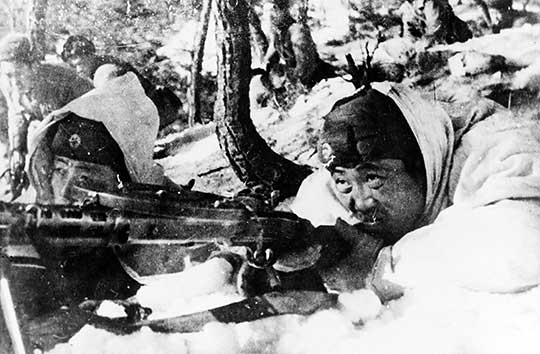The Armed Forces in the Korean War
North Korea, China and the USSR
The three communist nations which went to war with the United Nations were North Korea, China and the Soviet Union...
North Korea
In June 1950 North Korea launched 223,000 soldiers supported by 150 tanks across the border into South Korea. The North Korean People’s Army (KPA) was a conventional army equipped with Russian tanks, artillery and tactical aircraft. Many North Korean soldiers were hardened veterans of the war against Japan and the Chinese Civil War. KPA soldiers were well trained and equipped. Tactics were based on Soviet doctrine which emphasised rapid advances spearheaded by armoured and infantry assaults. The quality and power of the KPA’s initial invasion resulted in its opponents being forced back to the southern tip of the Korean peninsula. When Inchon and Seoul were recaptured by United Nations (UN) forces the KPA’s supply line was cut and it could not resist the powerful UN counter attack which followed. A hasty and disorganised retreat caused massive casualties and materiel losses for the KPA. The KPA reorganised following the Chinese intervention and for the remainder of the war the KPA played a much-reduced role in operations.

At left: a circular brass communist Chinese medal with a short chain and T-bar attached. The obverse of the medal shows a red enamelled communist Chinese flag above a map of Asia. Beneath this are two enamel scrolls, one red and one white, both containing Chinese characters. The obverse has been cast with the date '1950'. Collected by Private Jim Burgess who served in 3 Battalion, The Royal Australian Regiment (3RAR) during the Korean War. [AWM REL31170.002]
At right: a drawstring pouch with Chinese characters: Sergeant J H Welch, A Company, 1 Battalion, Royal Australian Regiment.
White cotton pouch with a drawstring around the top. The pouch has three large black Chinese characters on the front which can be translated as 'Consolation or Comfort Bag'. On either side are smaller characters with details of the recipient and donor. The characters on the right read 'The People's Army of Korea' and 'The Chinese Volunteer Forces'. Those on the left read 'Lina Cui, Grade Three, Jicheng Primary School, Third district, Tianjin, China'. [AWM REL30364] ... Enlarge the image of Chinese medal and pouch
China
During the Korean War the Chinese People’s Volunteer Army (PVA) sent two million soldiers to Korea. The PVA was a light infantry army having only a limited number of heavy weapons such as artillery, very few anti-aircraft guns, and no armoured vehicles. Compared to the UN forces it faced, the Chinese army was primitive in its communications, logistics and medical infrastructure.
A PVA Infantry Division numbered 10,000 soldiers. The initial 35 Divisions committed to Korea were well equipped but later units had to send men into battle armed only with grenades. Nevertheless, the Chinese soldier was a tenacious and formidable enemy. The average Chinese soldier was physically tough and committed to his cause. His officers were competent and experienced. Chinese tactics relied on overwhelming the enemy with numbers. The Chinese frequently launched human wave assaults against their foes, considering that losses were secondary to achieving battlefield success.
The Soviet Union
Despites its denials at the time, the Soviet Union was intimately involved in the Korean War. The contribution made by the Soviets was vital. They provided diplomatic support, strategic and grand tactical planning, including the planning of the invasion of South Korea, and essential logistical support. They supplied and trained the air forces of China and North Korea. Soviet pilots flew aircraft with Chinese or North Korean markings and after the war claimed to have shot down over 400 UN aircraft.










